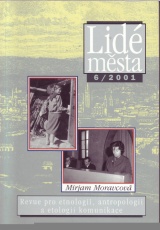Nad revitalizací tradičních slavností v Brně
(na příkladě hodů v Židenicích)
DOI:
https://doi.org/10.14712/12128112.4156Abstrakt
The social and cultural atmosphere of the past decade has prompted individuals, associations and interest groups in towns to revitalise the festivals which have followed up folk tradition in various degrees. Brno's cultural life has been typical of the presence of traditional rural culture, surviving until now. This has been fuelled by a close co-existence of the residents of Brno outskirts and the traditional culture of the town's rural background. After 1945 there was an effort to renew and preserve songs and old habits within the organised folklore movement in bands. The feasts constitute in the Brno suburbs a dominant popular festivity with an ancient tradition. In Židenice, which was attached to Brno in 1919, there were as recently as 1928 three feasts - the Wenceslas, Catherine and Imperial feasts. After 1990 the task of their renewal was taken up by a dancing group of young people called the "Židenice youth ", established at the local parish association. It organised the first feasts in 1998 to mark the consecration of the St Cyril and Methodius church. Others followed in 1999 and 2000. As regards the programme structure of feasts, organisers tried to preserve the traditional pattern which established itself around Brno at the close of the 19th century. This involved invitations through visits by miller´s assistants dressed in folk costumes, accompanied with dances and songs, offers of cakes and wine, the erection of maypoles under which the ceremony of donation of feast attributes was held, solemn marches of the miller's assistants through selected streets, maypole dances, night parties in pubs, etc. Masses and blessings in a church was a major part of the feast. One could observe in the basic structure of feasts a simplification and modification of individual elements. There was a change in the singing repertory (the band mainly played polkas and waltzes, and folk and popular songs were usually sung), while traditional dances were not renewed. However, the youth is trying to find and adopt the original local folk songs and dances, and in Židenice it is also reviving other habits and customs. lt is inspired by knowledge from literature and help by veterans. The Židenice feast is an opportunity for public entertainment focusing on spectators. It has a specific feature of a reconstruction of the original Židenice folk costume which has replaced the generally used Kyjov folk costume, generally considered as a representative of the national popular culture since the 19th century. In the context of the feast festival the folk costume is considered as a symbol of cultural distinctiveness of the place, as a self-identifying sign. The feast is an opportunity to rediscovering joint cultural roots of a given urban community. It helps surmount communication barriers and contribute to creating a counter-balance to the unified urban culture.
Stahování
Publikováno
Jak citovat
Číslo
Sekce
Licence

Tato práce je licencována pod Mezinárodní licencí Creative Commons Attribution-NonCommercial-NoDerivatives 4.0.


